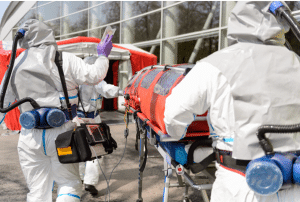Background
Hazardous material decontamination commonly referred to as hazmat decontamination is a vital step that aims at reducing the impact of hazardous materials on persons.
The background of Hazmat decontamination on patients stems from the necessity to safeguard the affected individuals and the medical professionals who are providing their treatment.
Hazmat incidents can be accidental and can happen in industries, transportation, or can be acts of terrorism. In such circumstances, the body gets contaminated on the skin, clothing or other mucous material cause health risks to the person.
Decontamination is characterized by a rigorous, step-by-step, and efficient strategy to eliminate toxic substances from the patient, including their garments. It usually occurs in decontamination zones that are fitted with requisite tools and procedures aimed at cleaning contaminated tools. As a result, this process fulfils several functions, such as protection against the contamination of the areas not infected by the pathogens, reduction of the potential secondary infection, and safeguarding the personnel caring for the patients.
Hazmat decontamination on patients can therefore be defined as a system which requires the input of emergency personnel, clinical practitioners, and personnel with specific knowledge of hazardous materials. It entails compliance with wearing of, PPE, and early response to curtail the effects of materials considered as hazardous.
Indications
Contraindications
Outcomes
Equipment
Decontamination Shower Systems
Water Supply
Decontamination Agents
Eye Wash Stations
Stretchers or Gurneys
Patient Preparation
Technique
The decontamination that is associated with hazmat is a process that is specifically structured and followed to eliminate a material or substance that has been deemed dangerous from a person who has had contact with it or has been affected by it in one way or the other.

Complications
Cross-Contamination:
Ineffective decontamination methods can disperse pollutants to uncontaminated regions or people.
Insufficient demarcation between areas polluted and uncontaminated.
Equipment Failure:
Inadequate functioning of decontamination showers, sprayers, or protective gears come in the way.
Lack of or failure of functioning decontamination equipment or adequate stock of decontamination material.
Human Error:
Lack of preparation or confusion as to processes and procedures.
Stress and exhaustion might cause errors or hasty decisions.
Resource Limitations:
Lack of people or capacity to perform the much larger scale of decontamination necessary.
Inadequate availability or accessibility of required decontamination centers or specific apparatus.
Waste Disposal:
Disposing of the contaminated waste materials and the wastewater in a way that does not pollute the environment.
Government regulations and the expenses related to the transportation and disposal of harmful substances.

Hazardous material decontamination commonly referred to as hazmat decontamination is a vital step that aims at reducing the impact of hazardous materials on persons.
The background of Hazmat decontamination on patients stems from the necessity to safeguard the affected individuals and the medical professionals who are providing their treatment.
Hazmat incidents can be accidental and can happen in industries, transportation, or can be acts of terrorism. In such circumstances, the body gets contaminated on the skin, clothing or other mucous material cause health risks to the person.
Decontamination is characterized by a rigorous, step-by-step, and efficient strategy to eliminate toxic substances from the patient, including their garments. It usually occurs in decontamination zones that are fitted with requisite tools and procedures aimed at cleaning contaminated tools. As a result, this process fulfils several functions, such as protection against the contamination of the areas not infected by the pathogens, reduction of the potential secondary infection, and safeguarding the personnel caring for the patients.
Hazmat decontamination on patients can therefore be defined as a system which requires the input of emergency personnel, clinical practitioners, and personnel with specific knowledge of hazardous materials. It entails compliance with wearing of, PPE, and early response to curtail the effects of materials considered as hazardous.
Decontamination Shower Systems
Water Supply
Decontamination Agents
Eye Wash Stations
Stretchers or Gurneys
The decontamination that is associated with hazmat is a process that is specifically structured and followed to eliminate a material or substance that has been deemed dangerous from a person who has had contact with it or has been affected by it in one way or the other.

Cross-Contamination:
Ineffective decontamination methods can disperse pollutants to uncontaminated regions or people.
Insufficient demarcation between areas polluted and uncontaminated.
Equipment Failure:
Inadequate functioning of decontamination showers, sprayers, or protective gears come in the way.
Lack of or failure of functioning decontamination equipment or adequate stock of decontamination material.
Human Error:
Lack of preparation or confusion as to processes and procedures.
Stress and exhaustion might cause errors or hasty decisions.
Resource Limitations:
Lack of people or capacity to perform the much larger scale of decontamination necessary.
Inadequate availability or accessibility of required decontamination centers or specific apparatus.
Waste Disposal:
Disposing of the contaminated waste materials and the wastewater in a way that does not pollute the environment.
Government regulations and the expenses related to the transportation and disposal of harmful substances.

Both our subscription plans include Free CME/CPD AMA PRA Category 1 credits.

On course completion, you will receive a full-sized presentation quality digital certificate.
A dynamic medical simulation platform designed to train healthcare professionals and students to effectively run code situations through an immersive hands-on experience in a live, interactive 3D environment.

When you have your licenses, certificates and CMEs in one place, it's easier to track your career growth. You can easily share these with hospitals as well, using your medtigo app.



